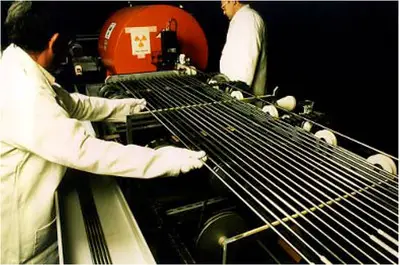5 Clean Energy Sources and Their Characteristics Explained
Clean energy sources are; ocean waves, solar radiation, wind, tides, and radioisotopes.
This article discusses clean energy sources and their attributes, as follows;
1). Ocean Waves (as one of the Clean Energy Sources)
The ocean is a clean source of energy that can be harnessed without risk of greenhouse emissions, resource depletion, or other common problems associated with energy development.
This is because of the dynamics of ocean water, that lead to the propagation of energized waves, tides and currents [2].
Ocean waves are a source of energy called wave energy; which is both clean and renewable. The natural processes and elements that produce wave energy are mainly solar heating, gravity and wind.
These elements act on ocean water, causing changes in its temperature, density and momentum, and mobilizing large water masses that act as an effective energy storage medium for potential, kinetic, thermal and mechanical energies.
Various types of wave converters are used to capture the energy of ocean waves, using this energy to generate electricity that can be used domestically, commercially and industrially.
Waves are said to have the highest energy density of all renewable and clean energy resources [5]. The potency of ocean waves as a source of clean energy is further helped by the abundance of ocean water which makes up a large portion of the Earth's surface.

2). Solar Radiation
Solar radiation is a naturally-occurring source of clean energy, which is abundant and renewable on the Earth's surface.
The reason(s) why solar energy is regarded as clean and renewable include the fact that this form of energy originates from nuclear fusion reactions that occur continuously, in large-scale, between the hydrogen isotopes (deuterium and tritium) that make up the Sun [4].
Solar radiation (and solar energy) can be said to contain two forms of energy; which are light and thermal (heat) energies.
The light energy from solar radiation is crucial to sustaining the Earth's natural ecosystems, because of its role in driving photosynthesis, by which plants manufacture their own food and bioenergy is generated.
This same energy is transferred from plants to other organisms in the ecosystem, as illustrated by ecologic models like energy pyramids and food chains.
Thermal energy from solar radiation is stored in oceans and harnessed as ocean thermal energy; which is another important form of renewable energy.
Other energy resources can be linked to solar radiation directly or indirectly, including wind, wave, hydro, and non-renewable fossil fuels.
3). Wind (as one of the Clean Energy Sources)
Wind is one of the cleanest energy resources on Earth alongside solar, as it comes from air currents and is not associated with any form of combustion that could cause gaseous emissions to occur.
Sources of wind energy include natural elements and processes like Earth's rotation, geomagnetic fields, solar heating (of atmospheric gases) and ocean-current dynamics. These are called 'sources' of wind energy because they play significant roles in the mobilization of large air masses.
One of the key advantages of wind energy as a clean alternative to fossil fuels, is its simplicity. Wind turbines can be used to capture and convert wind energy to electricity, in both onshore and offshore locations.
Compared to solar energy, wind is in fact less-clean, especially when evaluated from a lifecycle perspective.
This is because of the larger environmental footprint of wind energy projects; that comes from the scale, design, and materials used to make the various parts of a wind turbine. Efforts to improve the sustainability of wind energy have included modifications to the design and materials used to make wind turbines, with the aim to reduce areal coverage, and use materials that are easier to recycle.
4). Tides
Tidal energy or tidal power refers to energy that is contained in the ocean by reason of the periodic rise and fall of water levels, called tides.
It is considered clean and renewable because tidal energy comes solely from natural elements and processes that are continuously occurring and replenished in nature.
A major source of tidal energy is the effect of orbital revolution of the Earth, and the gravitational forces between the Sun, Moon and Earth [1].
Tidal energy is usually harnessed using reinforced turbines, that capture the rotary mechanical, potential and kinetic energies of ocean tides as they rise and fall.
Advantages of tidal energy include the renewable nature, non-toxic, and high energy-density attributes of tides.
5). Radioisotopes (as one of the Clean Energy Sources)
Radioisotopes contain nuclear energy which they release in the form of intense radiation as they undergo nuclear reactions and breakdown or 'decay'.
It must be noted that these radioisotopes are not renewable energy resources; but can release their stored energy without gaseous emissions; hence they are classified as clean energy resources.
In a nuclear power plant, radioisotopes are used to generate electricity by bombarding them with neutrons to facilitate radioactive fusion, so that the heat emitted is used to produce steam for driving a steam turbine-electric generator.
Radioisotopes are very important because they are the primary source of energy in other renewable systems including the Sun, and the Earth's core where geothermal reservoirs are found [3].

Conclusion
Clean energy sources are;
1. Ocean Waves
2. Solar Radiation
3. Wind
4. Tides
5. Radioisotopes
References
1). Bharthi, D., Hemavathi; Rani, S. (2017). "Tidal Energy- A Source Of Clean Energy." Available at: https://www.journalcra.com/article/tidal-energy-source-clean-energy. (Accessed 24 March 2023).
2). Martinez, M. L.; Silva, R.; Garcia, J. (2021). "How Can We Use Ocean Energy to Generate Electricity?" Available at: https://kids.frontiersin.org/articles/10.3389/frym.2021.609510. (Accessed 23 March 2023).
3). Putra, D. D.; Lelawati, I. (2014). "Finding Geothermal Energy Based on Radioisotopes Technology." Energy Procedia 47:71–75. Available at: https://doi.org/10.1016/j.egypro.2014.01.198. (Accessed 24 March 2023).
4). Ruchira, C. (2019). "Comparative Study of Nuclear Fusion with Other Renewable and Non Renewable Energy Sources." Advances in Power Generation from Renewable Energy Sources (APGRES) 2019. Available at: https://ssrn.com/abstract=3442573, http://dx.doi.org/10.2139/ssrn.3442573. (Accessed 24 March 2023).
5). Veerabhadrappa, K.; Suhas, B. G.; Mangrulkar, C. K.; Kumar, R. S.; Mudakappanavar, V. S.; Kambalur, N.; Seetharamu, K. N. (2022). "Power Generation Using Ocean Waves: A Review." Available at: https://doi.org/10.1016/j.gltp.2022.05.001. (Accessed 23 March 2023).





